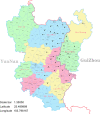Unique characteristics of G719X and S768I compound double mutations of epidermal growth factor receptor (EGFR) gene in lung cancer of coal-producing areas of East Yunnan in Southwestern China
- PMID: 35606799
- PMCID: PMC9125819
- DOI: 10.1186/s41021-022-00248-z
Unique characteristics of G719X and S768I compound double mutations of epidermal growth factor receptor (EGFR) gene in lung cancer of coal-producing areas of East Yunnan in Southwestern China
Abstract
Background: The principal objective of this project was to investigate the Epidermal Growth Factor Receptor (EGFR) gene mutation characteristics of lung cancer patients, which can provide a molecular basis for explaining the clinicopathological features, epidemiology and use of targeted therapy in lung cancer patients in the coal-producing areas of East Yunnan.
Methodology: We collected 864 pathologically confirmed lung cancer patients' specimens in First People's Hospital of Qujing City of Yunnan Province from September 2016 to September 2021. We thereafter employed Next Generation Sequencing (NGS) technology to detect all exons present in the EGFR gene.
Results: The overall mutation frequency of the EGFR gene was 47.22%. The frequency of EGFR gene mutations in the tissue, plasma, and cytology samples were found to be 53.40%, 23.33%, and 62.50%, respectively. Univariate analysis indicated that the coal-producing areas and Fuyuan county origin were significantly associated with relatively low EGFR gene mutation frequency. Female, non-smoking history, adenocarcinoma, non-brain metastasis, and tissue specimens were found to be related to high EGFR gene mutation frequency. Multivariate logistic regression analysis suggested the lung cancer patients in the central area of Qujing City, stage Ia, non-coal-producing areas, non-Fuyuan origin, and non-Xuanwei origin were more likely to develop EGFR gene mutations. The most common mutations were L858R point mutation (33.09%) and exon 19 deletion (19-del) (21.32%). Interestingly, the mutation frequency of G719X (p = 0.001) and G719X + S768I (p = 0.000) in the coal-producing areas were noted to be more significant than those in non-coal-producing regions.
Conclusion: This findings of this study might be important in establishing the correlation between routine using NGS for EGFR gene mutation diagnosis and clinical practice in the lung cancer patients.
Keywords: Coal-producing areas; EGFR gene mutation; G719X and S768I compound double mutation; Lung cancer.
© 2022. The Author(s).
Conflict of interest statement
All authors declare they have no actual or potential competing financial interest.
Figures



Similar articles
-
[Analysis of EGFR mutation and clinical features of lung cancer in Yunnan].Zhonghua Zhong Liu Za Zhi. 2020 Sep 23;42(9):729-734. doi: 10.3760/cma.j.cn112152-20200313-00201. Zhonghua Zhong Liu Za Zhi. 2020. PMID: 32988154 Chinese.
-
[Mutation status of epidermal growth factor receptor and KRAS gene in non-small cell lung cancers at Xuanwei regions of Yunnan Province].Zhonghua Bing Li Xue Za Zhi. 2016 Apr 8;45(4):226-30. doi: 10.3760/cma.j.issn.0529-5807.2016.04.003. Zhonghua Bing Li Xue Za Zhi. 2016. PMID: 27033384 Chinese.
-
Survival analysis of patients with advanced non-small cell lung cancer receiving EGFR-TKI treatment of Yunnan in southwestern China: a real-world study.Front Oncol. 2023 Oct 10;13:1156647. doi: 10.3389/fonc.2023.1156647. eCollection 2023. Front Oncol. 2023. PMID: 37881485 Free PMC article.
-
Distinct EGFR Mutation Pattern in Patients With Non-Small Cell Lung Cancer in Xuanwei Region of China: A Systematic Review and Meta-Analysis.Front Oncol. 2020 Nov 2;10:519073. doi: 10.3389/fonc.2020.519073. eCollection 2020. Front Oncol. 2020. PMID: 33224870 Free PMC article.
-
Successful Treatment of a Patient with Lung Adenocarcinoma Harboring Compound EGFR Gene Mutations, G719X and S768I, with Afatinib.Tokai J Exp Clin Med. 2020 Sep 20;45(3):113-116. Tokai J Exp Clin Med. 2020. PMID: 32901897 Review.
Cited by
-
Concurrent TP53 Mutations Facilitate Resistance Evolution in EGFR Exon 20 S768I Mutant Lung Adenocarcinoma: A Case Report and Review of the Literature.Case Rep Oncol. 2025 Jan 9;18(1):220-230. doi: 10.1159/000543453. eCollection 2025 Jan-Dec. Case Rep Oncol. 2025. PMID: 39980520 Free PMC article.
-
Exploring the conformational dynamics and thermodynamics of EGFR S768I and G719X + S768I mutations in non-small cell lung cancer: An in silico approaches.Open Life Sci. 2023 Nov 27;18(1):20220768. doi: 10.1515/biol-2022-0768. eCollection 2023. Open Life Sci. 2023. PMID: 38035047 Free PMC article.
References
Grants and funding
LinkOut - more resources
Full Text Sources
Research Materials
Miscellaneous

